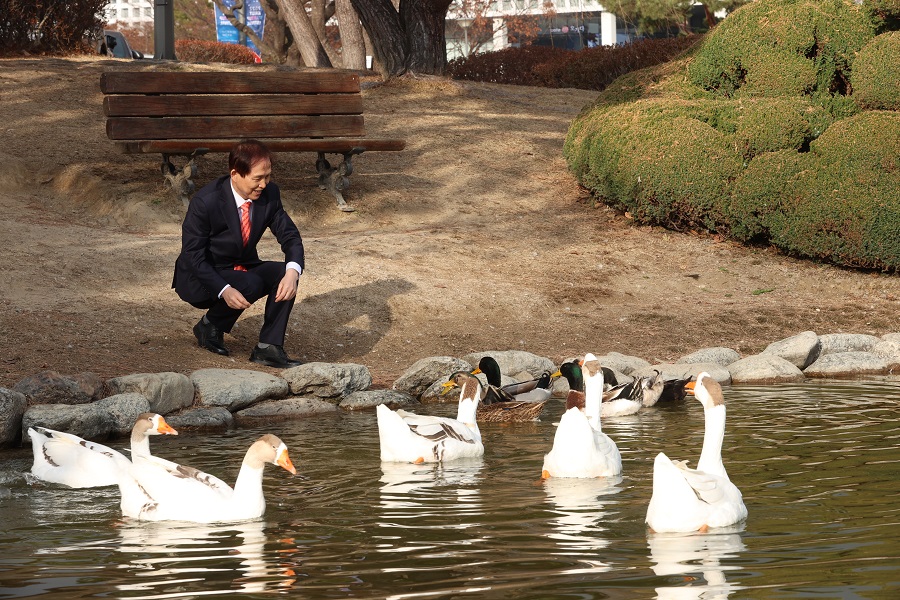people
In October of this year, KAIST signed an 'Agreement for the Training Program for AI Semiconductor Designers' with Samsung Electronics, to conduct joint research and actively nurture master's and doctorate researchers in the field of Semiconductors designed exclusively for AI devices. To celebrate this commemorative agreement for cooperation bound for mutual success, Samsung Electronics gifted a set of 5 ducks to KAIST.
The Duck Pond and the Geese have been representing KAIST as famous mascots.

It all started back in 2000, when the incumbent President, Professor Kwang Hyung Lee served was then a professor at the Department of Bio and Brain Engineering, he first picked up a pack of ducks from Yuseong Market and started taking care of it on campus around the Carillon pond. While the ducks came and went, eventually being replaced with a pack of geese over the time, for more than 20 years, the pack of feathery KAISTians stole the eyes of the passersby and were loved by both the on-campus members and the visitors, alike.
The representative of the Samsung Electronics said that the pack of ducks comprising of a new breed contains the message of SEC that it hopes that the PIM semiconductor technology will grow to become the super-gap technology that would turn heads and grab attention of the world as the mascot of Korea's technological prowess under the combined care of KAIST and SEC.
Would the ducks find KAIST likable? We will keep you informed of how they are doing!
-
research KAIST sends out Music and Bio-Signs of Professor Kwon Ji-yong, a.k.a. G-Dragon, into Space to Pulsate through Universe and Resonate among Stars
KAIST (President Kwang-Hyung Lee) announced on the 10th of April that it successfully promoted the world’s first ‘Space Sound Source Transmission Project’ based on media art at the KAIST Space Research Institute on April 9th through collaboration between Professor Jinjoon Lee of the Graduate School of Culture Technology, a world-renowned media artist, and the global K-Pop artist, G-Dragon. This project was proposed as part of the ‘AI Entertech Research Center’ be
2025-04-10 -
event KAIST, Galaxy Corporation Hold Signboard Ceremony for ‘AI Entertech Research Center’
KAIST (President Kwang-Hyung Lee) announced on the 9th that it will hold a signboard ceremony for the establishment of the ‘AI Entertech Research Center’ with the artificial intelligence entertech company, Galaxy Corporation (CEO Yong-ho Choi) at the main campus of KAIST. < (Galaxy Corporation, from center to the left) CEO Yongho Choi, Director Hyunjung Kim and related persons / (KAIST, from center to the right) Professor SeungSeob Lee of the Department of Mechanical Engineer
2025-04-09 -
research KAIST Identifies Master Regulator Blocking Immunotherapy, Paving the Way for a New Lung Cancer Treatment
Immune checkpoint inhibitors, a class of immunotherapies that help immune cells attack cancer more effectively, have revolutionized cancer treatment. However, fewer than 20% of patients respond to these treatments, highlighting the urgent need for new strategies tailored to both responders and non-responders. KAIST researchers have discovered that 'DEAD-box helicases 54 (DDX54)', a type of RNA-binding protein, is the master regulator that hinders the effectiveness of immunotherapy—opening
2025-04-08 -
research KAIST Develops Retinal Therapy to Restore Lost Vision
Vision is one of the most crucial human senses, yet over 300 million people worldwide are at risk of vision loss due to various retinal diseases. While recent advancements in retinal disease treatments have successfully slowed disease progression, no effective therapy has been developed to restore already lost vision—until now. KAIST researchers have successfully developed a novel drug to restore vision. < Photo 1. (From left) Ph.D. candidate Museong Kim, Professor Jin Woo Kim, a
2025-03-31 -
research KAIST provides a comprehensive resource on microbial cell factories for sustainable chemical production
In silico analysis of five industrial microorganisms identifies optimal strains and metabolic engineering strategies for producing 235 valuable chemicals Climate change and the depletion of fossil fuels have raised the global need for sustainable chemical production. In response to these environmental challenges, microbial cell factories are gaining attention as eco-friendly platforms for producing chemicals using renewable resources, while metabolic engineering technologies to enhance these
2025-03-27